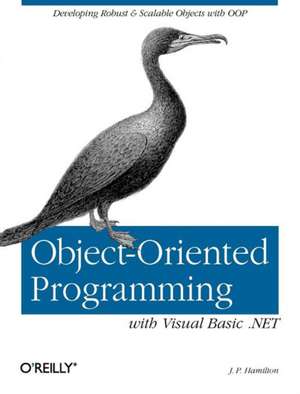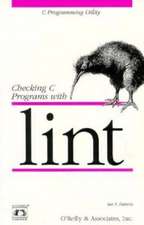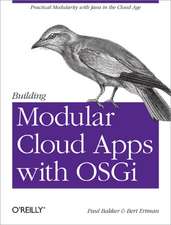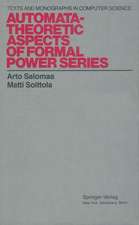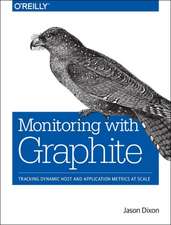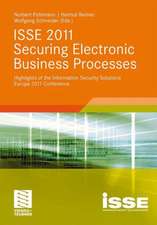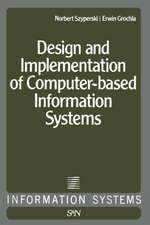Object–Oriented Programming with Visual Basic.NET
Autor J P Hamiltonen Limba Engleză Paperback – 24 oct 2002
Preț: 170.51 lei
Preț vechi: 213.14 lei
-20% Nou
Puncte Express: 256
Preț estimativ în valută:
32.63€ • 35.43$ • 27.41£
32.63€ • 35.43$ • 27.41£
Carte disponibilă
Livrare economică 01-15 aprilie
Preluare comenzi: 021 569.72.76
Specificații
ISBN-13: 9780596001469
ISBN-10: 0596001460
Pagini: 308
Dimensiuni: 181 x 231 x 17 mm
Greutate: 0.49 kg
Editura: O'Reilly
Locul publicării:United States
ISBN-10: 0596001460
Pagini: 308
Dimensiuni: 181 x 231 x 17 mm
Greutate: 0.49 kg
Editura: O'Reilly
Locul publicării:United States
Cuprins
Preface;
Audience;
About This Book;
Assumptions This Book Makes;
Conventions Used in This Book;
How to Contact Us;
Acknowledgments;
Chapter 1: Introduction;
1.1 Visual Basic .NET and Object-Oriented Programming;
1.2 The .NET Framework;
Chapter 2: Object Fundamentals;
2.1 Creating and Compiling the Component;
2.2 Namespaces;
2.3 Using a Component;
2.4 Application Domains;
2.5 Contexts;
2.6 Assemblies;
2.7 Intermediate Language;
2.8 The Global Assembly Cache;
2.9 System Namespace;
Chapter 3: Class Anatomy;
3.1 Member Variables;
3.2 Properties;
3.3 Methods;
3.4 Access Modifiers;
3.5 Passing Parameters;
3.6 Value Types;
3.7 Creation and Destruction;
3.8 Delegates and Events;
3.9 Design Considerations;
3.10 An Exercise;
Chapter 4: Object-Orientation;
4.1 Generalization and Specialization;
4.2 Inheritance;
4.3 Containment;
4.4 Polymorphism;
4.5 Overloading;
4.6 Overriding;
4.7 Substitution;
Chapter 5: Interfacing .NET;
5.1 Private Implementation;
5.2 Versioning;
5.3 Interfaces Versus Abstract Base Classes;
5.4 Interfaces in .NET;
5.5 Design Considerations;
Chapter 6: Exceptional Objects;
6.1 The Basics of Exception Handling;
6.2 Unhandled Exception Handler;
6.3 The StackTrace Object;
6.4 Resuming Code;
6.5 Retrying Code;
6.6 Performance Counters;
Chapter 7: Object Inspection;
7.1 Reflection;
7.2 Runtime Type Discovery;
7.3 Dynamic Type Loading;
7.4 Attributes;
7.5 Custom Attributes;
Chapter 8: Object In, Object Out;
8.1 Streams;
8.2 Readers and Writers;
8.3 Serialization;
8.4 Schema Definition Tool;
8.5 Custom Serialization;
8.6 NetworkStream;
Chapter 9: Object Remoting;
9.1 Channels;
9.2 A Remotable Object;
9.3 Windows Services;
9.4 The Client;
9.5 Designing for Remoting;
9.6 Marshal by Value (MBV);
9.7 Hosting Objects in IIS;
9.8 Windows Service Versus IIS;
9.9 Authentication;
Chapter 10: Web Services;
10.1 Writing a Web Service;
10.2 Web Services Versus Remoting;
10.3 Using Web Services from .NET Remoting;
10.4 Compatibility;
10.5 UDDI;
10.6 Accessing Data for the Web Service;
Bibliography;
Colophon;
Audience;
About This Book;
Assumptions This Book Makes;
Conventions Used in This Book;
How to Contact Us;
Acknowledgments;
Chapter 1: Introduction;
1.1 Visual Basic .NET and Object-Oriented Programming;
1.2 The .NET Framework;
Chapter 2: Object Fundamentals;
2.1 Creating and Compiling the Component;
2.2 Namespaces;
2.3 Using a Component;
2.4 Application Domains;
2.5 Contexts;
2.6 Assemblies;
2.7 Intermediate Language;
2.8 The Global Assembly Cache;
2.9 System Namespace;
Chapter 3: Class Anatomy;
3.1 Member Variables;
3.2 Properties;
3.3 Methods;
3.4 Access Modifiers;
3.5 Passing Parameters;
3.6 Value Types;
3.7 Creation and Destruction;
3.8 Delegates and Events;
3.9 Design Considerations;
3.10 An Exercise;
Chapter 4: Object-Orientation;
4.1 Generalization and Specialization;
4.2 Inheritance;
4.3 Containment;
4.4 Polymorphism;
4.5 Overloading;
4.6 Overriding;
4.7 Substitution;
Chapter 5: Interfacing .NET;
5.1 Private Implementation;
5.2 Versioning;
5.3 Interfaces Versus Abstract Base Classes;
5.4 Interfaces in .NET;
5.5 Design Considerations;
Chapter 6: Exceptional Objects;
6.1 The Basics of Exception Handling;
6.2 Unhandled Exception Handler;
6.3 The StackTrace Object;
6.4 Resuming Code;
6.5 Retrying Code;
6.6 Performance Counters;
Chapter 7: Object Inspection;
7.1 Reflection;
7.2 Runtime Type Discovery;
7.3 Dynamic Type Loading;
7.4 Attributes;
7.5 Custom Attributes;
Chapter 8: Object In, Object Out;
8.1 Streams;
8.2 Readers and Writers;
8.3 Serialization;
8.4 Schema Definition Tool;
8.5 Custom Serialization;
8.6 NetworkStream;
Chapter 9: Object Remoting;
9.1 Channels;
9.2 A Remotable Object;
9.3 Windows Services;
9.4 The Client;
9.5 Designing for Remoting;
9.6 Marshal by Value (MBV);
9.7 Hosting Objects in IIS;
9.8 Windows Service Versus IIS;
9.9 Authentication;
Chapter 10: Web Services;
10.1 Writing a Web Service;
10.2 Web Services Versus Remoting;
10.3 Using Web Services from .NET Remoting;
10.4 Compatibility;
10.5 UDDI;
10.6 Accessing Data for the Web Service;
Bibliography;
Colophon;
